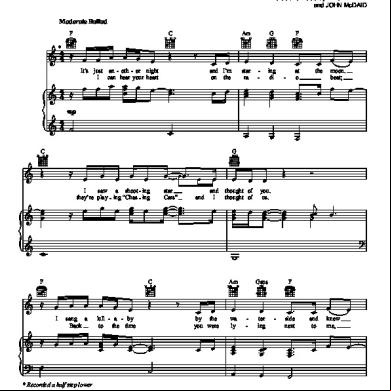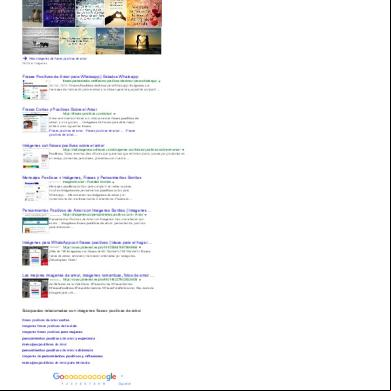Api Gravity Exp 3sd59
This document was ed by and they confirmed that they have the permission to share it. If you are author or own the copyright of this book, please report to us by using this report form. Report 3i3n4
Overview 26281t
& View Api Gravity Exp as PDF for free.
More details 6y5l6z
- Words: 430
- Pages: 5
OBJECTIVE The objective of this experiment are to determine specific gravity of oil using hydrometer and density meter and to compare specific gravity and API gravity of different oils.
1 | Page
SUMMARY API gravity is the most commonly used property to classify crude oil and refined petroleum products since the early days of petroleum industry. It has also been used to predict many other characteristics of petroleum oils. The objective of this experiment is to determine specific gravity of oil using hydrometer and density meter and to compare specific gravity and API gravity of different oils. In this experiment, to determine density or specific gravity of liquid were used hydrometer and density meter. There are four types of sample used in this experiment, which are petrol, kerosene, diesel and lubricating oil. Usually, hydrometer were used for determining oil gravity in the oil field. Hydrometer also can be used at atmospheric pressure or at any other pressure in a pressure cylinder. However, the portable density meter is an accurate tool to determine the density of the sample. In this experiment, the experimenter were introduced to determine the differences the specific gravity of oil by using hydrometer and density meter methods.
2 | Page
CONCLUSION From this experiment can be conclude that to determine the specific gravity of oil using hydrometer and density meter and to compare specific gravity and API gravity of different oils, where the hydrometer and density meter that have been used to different type of samples. Based on the results, Lubricating oil has the highest density value followed by diesel, kerosene and petrol. It had shown the density meter is more accurate compared to hydrometer. There were several errors were occurred in this experiment. To overcome the error is the observer’s eye must squarely aligned with the pointer and scale to avoid the parallax error. Next, the density meter must be drain and rinse to avoid a contaminant in samples.
3 | Page
REFERENCES 1. Uttam Ray Chaudhuri, Fundamentals of Petroleum and Petrochemical Engineering Chemical Industries., CRC Press, 2010 (BOOK) 2. Francis S. Manning,Richard E. Thompson (Ph.D.), Richard E. Thompson, Oilfield Processing of Petroleum: Crude oil Jilid 2 daripada Oilfield Processing of Petroleum,Francis S. Manning, PennWell Books, 1995. (BOOK) 3. Ulag Mahadevan, Fundamentals of Petroleum and Petrochemical Engineering, Gazelle Book Services, 2012. (BOOK) 4. Navid Naderpour, Petrochemical Production Processes, Sbs Publishers & Distributors, 2008 (BOOK) 5. J. Matthew Neal, Specific Gravity, Lulu.com, 2008. (BOOK)
4 | Page
CONTENT INDEX SUMMARY OBJECTIVE DATA AND RESULTS
ANALYSIS AND DISCUSSION
CONCLUSION AND RECOMMENDATION TUTORIAL REFERENCES APPENDICES
5 | Page
PAGE
1 | Page
SUMMARY API gravity is the most commonly used property to classify crude oil and refined petroleum products since the early days of petroleum industry. It has also been used to predict many other characteristics of petroleum oils. The objective of this experiment is to determine specific gravity of oil using hydrometer and density meter and to compare specific gravity and API gravity of different oils. In this experiment, to determine density or specific gravity of liquid were used hydrometer and density meter. There are four types of sample used in this experiment, which are petrol, kerosene, diesel and lubricating oil. Usually, hydrometer were used for determining oil gravity in the oil field. Hydrometer also can be used at atmospheric pressure or at any other pressure in a pressure cylinder. However, the portable density meter is an accurate tool to determine the density of the sample. In this experiment, the experimenter were introduced to determine the differences the specific gravity of oil by using hydrometer and density meter methods.
2 | Page
CONCLUSION From this experiment can be conclude that to determine the specific gravity of oil using hydrometer and density meter and to compare specific gravity and API gravity of different oils, where the hydrometer and density meter that have been used to different type of samples. Based on the results, Lubricating oil has the highest density value followed by diesel, kerosene and petrol. It had shown the density meter is more accurate compared to hydrometer. There were several errors were occurred in this experiment. To overcome the error is the observer’s eye must squarely aligned with the pointer and scale to avoid the parallax error. Next, the density meter must be drain and rinse to avoid a contaminant in samples.
3 | Page
REFERENCES 1. Uttam Ray Chaudhuri, Fundamentals of Petroleum and Petrochemical Engineering Chemical Industries., CRC Press, 2010 (BOOK) 2. Francis S. Manning,Richard E. Thompson (Ph.D.), Richard E. Thompson, Oilfield Processing of Petroleum: Crude oil Jilid 2 daripada Oilfield Processing of Petroleum,Francis S. Manning, PennWell Books, 1995. (BOOK) 3. Ulag Mahadevan, Fundamentals of Petroleum and Petrochemical Engineering, Gazelle Book Services, 2012. (BOOK) 4. Navid Naderpour, Petrochemical Production Processes, Sbs Publishers & Distributors, 2008 (BOOK) 5. J. Matthew Neal, Specific Gravity, Lulu.com, 2008. (BOOK)
4 | Page
CONTENT INDEX SUMMARY OBJECTIVE DATA AND RESULTS
ANALYSIS AND DISCUSSION
CONCLUSION AND RECOMMENDATION TUTORIAL REFERENCES APPENDICES
5 | Page
PAGE










